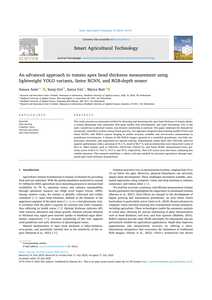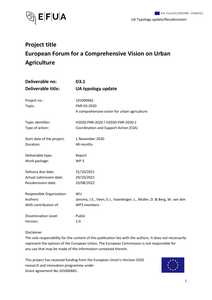This study presents an automated method for detecting and measuring the apex head thickness of tomato plants, a critical phenotypic trait associated with plant health, fruit development, and yield forecasting. Due to the apex's sensitivity to physical contact, non-invasive monitoring is essential. This paper addresses the demand for automated, contactless systems among Dutch growers. Our approach integrates deep learning models (YOLO and Faster RCNN) with RGB-D camera imaging to enable accurate, scalable, and non-invasive measurement in greenhouse environments. A dataset of 600 RGB-D images captured in a controlled greenhouse, was fully preprocessed, annotated, and augmented for optimal training. Experimental results show that YOLOv8n achieved superior performance with a precision of 91.2 %, recall of 86.7 %, and an Intersection over Union (IoU) score of 89.4 %. Other models, such as YOLOv9t, YOLOv10n, YOLOv11n, and Faster RCNN, demonstrated lower precision scores of 83.6 %, 74.6 %, 75.4 %, and 78 %, respectively. Their IoU scores were also lower, indicating less reliable detection. This research establishes a robust, real-time method for precision agriculture through automated apex head thickness measurement.
DOCUMENT

Animal welfare is a multidimensional phenomenon and currently its on-farm assessment requires complex, multidimensional frameworks involving farm audits which are time-consuming, infrequent and expensive. The core principle of precision agriculture is to use sensor technologies to improve the efficiency of resource use by targeting resources to where they give a benefit. Precision livestock farming (PLF) enables farm animal management to move away from the group level to monitoring and managing individual animals. A range of precision livestock monitoring and control technologies have been developed, primarily to improve livestock production efficiency. Examples include using camera systems monitoring the movement of housed broiler chickens to detect problems with feeding systems or disease and leg-mounted accelerometers enabling the detection of the early stages of lameness in dairy cows. These systems are already improving farm animal welfare by, for example, improving the detection of health issues enabling more rapid treatment, or the detection of problems with feeding systems helping to reduce the risk of hunger. Environmental monitoring and control in buildings can improve animal comfort, and automatic milking systems facilitate animal choice and improve human-animal interactions. Although these precision livestock technologies monitor some parameters relevant to farm animal welfare (e.g. feeding, health), none of the systems yet provide the broad, multidimensional integration that is required to give a complete assessment of an animal’s welfare. However, data from PLF sensors could potentially be integrated into automated animal welfare assessment systems, although further research is needed to define and validate this approach.
DOCUMENT

Inaugural lecture as Lector Precision Livestock Farming at HAS University of Applied Sciences on October 14, 2016. PLF, Precision Livestock Farming, uses technologies to continuously monitor animal behaviour, animal health, production and environmental impact.
DOCUMENT

Reducing the use of pesticides by early visual detection of diseases in precision agriculture is important. Because of the color similarity between potato-plant diseases, narrow band hyper-spectral imaging is required. Payload constraints on unmanned aerial vehicles require reduc- tion of spectral bands. Therefore, we present a methodology for per-patch classification combined with hyper-spectral band selection. In controlled experiments performed on a set of individual leaves, we measure the performance of five classifiers and three dimensionality-reduction methods with three patch sizes. With the best-performing classifier an error rate of 1.5% is achieved for distinguishing two important potato-plant diseases.
MULTIFILE

Urban Agriculture (UA) is rapidly evolving and changing and often entails more than the production of food. EFUA’s Working Package 3 therefore aims to identify the types and benefits of UA in the European context. This report is an update of the typology as described in the COST Action UAE. As existing typologies are often based on subjective observation rather than on empirical data and are also one-dimensional, this study is based on a systematic literature review about characteristics and existing typologies of UA, interviews with sixteen experts in the field representing eleven European countries and a questionnaire about specific UA initiatives amongst 112 respondents.
DOCUMENT

Inaugurele rede als Lector Precision Livestock Farming bij HAS hogeschool op 14 oktober 2016. PLF, in het Nederlands Precisielandbouw in de veehouderij, maakt gebruik van technologieën om diergedrag, diergezondheid, productie en milieubelasting continu te monitoren.
DOCUMENT

Students, researchers, professors and company representatives gathered to share progress and ideas at the second half-year symposium of HiPerGreen at the World Horti Center in Naaldwijk. HiPerGreen is a Raak MKB subsidised research project aiming to bring value to horticultural growers. Cock Heemskerk, head of the HiPerGreen project and lector Robotica at InHolland University of Applied Sciences, welcomed everyone and gave an overall status update. Then Lucien, Fesselet project manager at HiPerGreen, talked about the minimal viable product (MVP) to make automated detection of fusarium in Phalaenopsis (a type of orchid) possible. Three consortium partners were invited to explain what they do for HiPerGreen and what their motives for participation are: Igno Breukers (DB2-Vision, start-up of a new type of multispectral camera for Precision Agriculture), Tim Brander (head grower at Hazeu Orchids) and Tom Kearny-Mitchel (plant biology advisor at Applied Drone Innovations). Next several students summarised their team’s work, findings and failures to the audience. During the live demo Lucien unveiled one of the team’s newly-built technologies: live stream thermal images of plants. The sympoium was concluded with a brainstorm session and drink.
DOCUMENT

The EIP-AGRI Focus Group on Bee health and sustainable beekeeping was established in spring 2019 to identify, structure and develop main replies to the main question: How can we ensure the sustainability of beekeeping in the face of challenges linked to pests and diseases, intensification of agriculture and climate change?
DOCUMENT

Several studies have suggested that precision livestock farming (PLF) is a useful tool foranimal welfare management and assessment. Location, posture and movement of an individual are key elements in identifying the animal and recording its behaviour. Currently, multiple technologies are available for automated monitoring of the location of individual animals, ranging from Global Navigation Satellite Systems (GNSS) to ultra-wideband (UWB), RFID, wireless sensor networks (WSN) and even computer vision. These techniques and developments all yield potential to manage and assess animal welfare, but also have their constraints, such as range and accuracy. Combining sensors such as accelerometers with any location determining technique into a sensor fusion systemcan give more detailed information on the individual cow, achieving an even more reliable and accurate indication of animal welfare. We conclude that location systems are a promising approach to determining animal welfare, especially when applied in conjunction with additional sensors, but additional research focused on the use of technology in animal welfare monitoring is needed.
DOCUMENT

The current western agrifood system is highly successful in providing for human needs. However, the dominant agricultural approach of up-scaling and specialisation is put under pressure by a number of developments in the global landscape. Global developments such as population growth, pollution, soil degradation and climate change, in which agriculture plays a crucial role, make the need for a transition towards a paradigm with a broader range of values evident. Niche initiatives often develop as a reaction to needs not fulfilled by the regime. Therefore, certain niches may have the potential of driving a necessary transition. This research aims to determine if permaculture, being a niche, has this potential. The main question for this research was formulated as follows: How can a production system based on permaculture principles contribute to the agrifood transition? To answer this question, relevant current trends and global developments were used as a basis for developing a future scenario. Empirical qualitative data on permaculture businesses in the Netherlands was gathered as well, of which the results were used for a determination of permaculture’s performance in this future scenario. This was done by comparing a standardised permaculture system with a conventional potato system. As a result of this comparison, the Unique Selling Points of permaculture were identified, which determine the future potential of permaculture.
DOCUMENT
